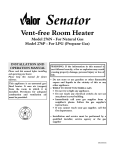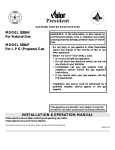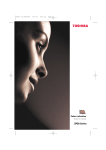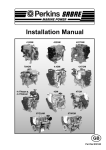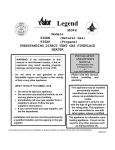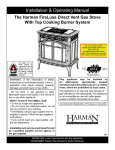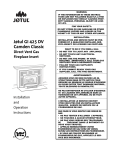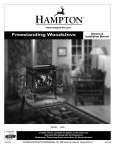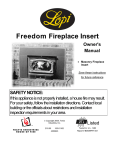Download Valor Legend 937XP Owner`s manual
Transcript
Legend MODEL 937XN FOR USE WITH NATURAL GAS MODEL 937XP FOR USE WITH PROPANE VENTED GAS FIREPLACE HEATERS WARNING: If the information in this manual is not followed exactly, a fire or explosion may result causing property damage, personal injury or loss of life - Do not store or use gasoline or other flammable vapors and liquids in the vicinity of this or any other appliance. INSTALLATION AND OWNER’S MANUAL For Pedestal base with Contemporary front or Legs with Traditional front Please read this manual before installing and operating this heater. - WHAT TO DO IF YOU SMELL GAS • Open windows • Extinguish any open flame • Do not try to light any appliance. • Do not touch any electrical switch; do not use any phone in your building. • Immediately call your gas supplier from a This appliance is a neighbor’s phone. Follow the gas supplier’s domestic room heating instructions. appliance. It must not be • If you cannot reach your gas supplier, call used for any other the fire department. purpose such as drying - Installation and service must be performed by a clothes etc. qualified installer, service agency or the gas supplier. Vous pourrez vous procurer un exemplaire en langue française de cette brochure chez votre concessionnaire 600B257/01 CONTENTS SAFETY INFORMATION...................................................................................................................................................................................................... 3 1 OPTIONS......................................................................................................................................................................................................................... 4 2. GENERAL DATA............................................................................................................................................................................................................. 4 3. LOCATION IN THE ROOM ........................................................................................................................................................................................ 4 4. SUPPLY GAS..................................................................................................................................................................................................................... 4 5. PACK CONTENTS......................................................................................................................................................................................................... 6 6. APPLIANCE PREPARATION........................................................................................................................................................................................ 6 7. GAS SUPPLY INSTALLATION..................................................................................................................................................................................... 7 8. BASE & MAIN APPLIANCE INSTALLATION .......................................................................................................................................................... 8 9. VENT CONNECTION.................................................................................................................................................................................................. 9 10. GAS LINE CONNECTION..................................................................................................................................................................................... 10 11. SYSTEM CHECK ....................................................................................................................................................................................................... 10 12. CERAMIC FUEL BED ASSEMBLY......................................................................................................................................................................... 11 13. CONTROLS OPERATION CHECK ...................................................................................................................................................................... 12 14. AERATION ADJUSTMENT.................................................................................................................................................................................... 13 15. FASCIA INSTALLATION ........................................................................................................................................................................................ 13 16. VENTING CHECK ................................................................................................................................................................................................... 14 17. FINAL CHECK .......................................................................................................................................................................................................... 14 18. OPERATING THE HEATER.................................................................................................................................................................................... 15 19. LIGHTING WITH A LONG MATCH.................................................................................................................................................................... 15 20. CLEANING................................................................................................................................................................................................................ 15 21. CHECKS...................................................................................................................................................................................................................... 16 22. SERVICING................................................................................................................................................................................................................ 16 23. LIGHTING INSTRUCTIONS................................................................................................................................................................................. 17 2 SAFETY INFORMATION Due to high temperatures, the appliance should be located out of traffic and away from furniture and draperies. Children and adults should be alerted to the hazards of high surface temperatures and should stay away to avoid burns or clothing ignition. Young children should be carefully supervised when they are in the same room as the appliance. Clothing or other flammable material should not be placed on or near the appliance. The glass and front frame must be put back in place prior to operating the appliance if they have been removed for servicing or cleaning. Never operate with broken or damaged window glass. This appliance should be installed and repaired by a qualified service person. The appliance should be inspected before use and at least annually by a professional service person. More frequent cleaning may be required due to excessive lint from carpeting, bedding material, etc. It is imperative that control compartments, burners and circulating air passageways of the appliance are kept clean. Keep curtains, clothing, furniture and other flammable materials at least 36ins (90cm) from all parts of the appliance If any changes are made to the room construction in the vicinity of the appliance after installation (e.g. additional mantle etc.) make sure that the changes conform to the installation requirements in this manual. Never attempt to burn paper or any other material in the appliance. Keep the base of the appliance clear to prevent obstruction of air flow to the appliance. If fitted with a pedestal base, make sure that the grill at back is not obstructed. If fitted with legs, make sure there is no obstruction between the legs. This appliance must be properly connected to a venting system. It is equipped with a vent safety shutoff system. Operating when not connected to a properly installed and maintained venting system or tampering with the shutoff system can result in carbon monoxide (CO) poisoning and possible death. The venting system should be checked periodically. Recent trends in home improvement and new tighter construction techniques have contributed to problems with venting. If you suspect that your appliance is not venting properly, do not operate. Seek expert advice. Do not use this appliance if any part has been under water. Immediately call a qualified service technician to inspect the appliance and to replace any part of the control system and any gas control which has been under water. Keep the appliance area well clear and free from combustible materials, gasoline and other flammable vapors and liquids. NOTE When operating your new stove for the first time, some vapors may be released which may cause a slight odor and could possibly set off any smoke detection alarms in the immediate vicinity. These vapors are quite normal on new appliances. They are totally harmless and will disappear after a few hours use. 3 1 OPTIONS #710 CFK Circulating fan kit (For pedestal base only) is available as an option for this appliance. Operated by a variable speed controller, it is designed to boost the natural convection process through the heater. It may be fitted before the heater is installed or retrofitted at a later date. Full installation and operating instructions are included with the kit. 2. GENERAL DATA This appliance is certified by International Approval Services for use in Canada and the USA. The appliance complies with CGA P.4.1, Testing method for measuring annual fireplace efficiencies. The installation must conform with local codes or, in the absence of local codes with the National Fuel Gas Code, ANSI Z223.1 or the Canadian installation code CAN/CGA-149. Only qualified licensed or trained personnel should install the appliance. The appliance, when installed, must be electrically grounded in accordance with local codes or, in the absence of local codes, with the National Electrical Code, ANSI/NFPA 70 or the Canadian Electrical Code, CSA C22.1 This appliance is only for use with the type of gas indicated on the rating plate. 2.1 Rating plate 2.2 Rates (Btu/h) Altitude (feet) The rating plate is located inside the control compartment door. Natural gas Max Min 0-4500 27,000 Input 0-4500 19,000 Output 2.3 Pressures (in. w.c.) Natural. gas Supply upstream of regulator Max Min 4 10.5 5.0 Manifold tapping on thermostat (appliance full on) 3.7 3.3 8,000 Propane Max Min 26,500 18,815 8,000 Propane Supply upstream of regulator 14.0 11.0 Manifold tapping on thermostat (appliance full on) 9.5 9.1 2.4 Orifice data 2.5 Venting For verification only. Do not attempt to drill or otherwise modify the appliance input. Natural Gas Propane Type No of Dia. Type No of Dia. holes (ins) holes (ins) Pilot 40 1 0.022 14 1 0.014 Front 187 0.027 105 1 0.042 360 Rear 187 0.027 105 1 0.042 360 This appliance is for connection to an approved 4” metal vent. 3. LOCATION IN THE ROOM Combustible materials inside the room must not be closer than the dimensions shown in figure 1. The floor construction should allow the heater to be screwed to the floor. If the heater is to be installed directly on any combustible material other than wood flooring, it must be installed on a metal or wood panel extending the full width and depth of the appliance. 4. SUPPLY GAS Model 937XN is for use only with natural gas. Model 937XP is for use only with propane gas. The supply pressure must be between the limits shown in section 2.3 of this manual. The supply connection is 3/8”NPT. Openings for the gas supply are provided for rear or underfloor connection (see figure 1). WITH PEDESTAL WITH LEGS Fig. 1 Dimensions & clearances 5 5. PACK CONTENTS The complete appliance is contained in two packs. One of the alternative base support and front designs will be included - either pedestal with contemporary fascia or Legs with traditional fascia (See pack 2). Pack 1 - Main appliance unit contains:1 Main appliance fitted with window. 4 Ceramic logs. 1 Pair ceramic firebox side walls. 1 Ceramic firebox back wall. 1 Decorative vent collar for appliance top. 1 Gas supply inlet pipe. 1 Gas supply inlet elbow. 1 Exhaust port cover Pack 2 - Pedestal and contemporary fascia alternative contains:1 Pedestal unit. 1 Contemporary design front fascia unit. 1 Ashlip unit. 4 #8 tapping screws (for fixing ashlip). 4 Machine screws (for fixing pedestal to main appliance). 2 Wood screws (for floor fixing). 2 Plugs (for floor fixing). or Pack 2 - Legs and traditional fascia alternative contains:1 Base & legs unit. 1 Traditional design front fascia unit. 1 Door retaining bracket. 1 Window frame top cover. 2 #10 tapping screws (for door retaining bracket). 4 Machine screws (for fixing base & leg unit to main appliance). 2 Wood screws (for floor fixing). 2 Plugs (for floor fixing). Take care when removing the contents from the packaging to prevent damage. Check that all the contents are in the packs and are undamaged. 6. 6.1 6.1.1 6.1.2 6.1.3 APPLIANCE PREPARATION Remove the window & logs (see figure 2) Detach the window unit by removing the two knurled screws (“A”) and knurled nut (“B”) holding the sides and bottom of the window frame. Lift the window unit up and forwards to unhook the top. Put the window in a safe place. Take the ceramic logs out of the firebox and store safely. Fig. 2 Window removal 6.2 Check ignition electrode spark (see figure 3) The pilot burner and electrode are at the right side of the firebox. Open the control access door. Turn the gas control knob (the right hand knob) counterclockwise to “Ign”. While turning pilot ignition sparks should be activated twice. Check that the sparks are produced at the pilot burner. If no sparks are produced, check that the wiring is secure and that the spark gap is 3.5 + 0.5 mm. Fig. 3 Pilot ignition system 6 6.3 Fit exhaust port cover (see figure 4) Remove four screws from under the top of the firebox. Fit the exhaust port cover and secure with the four screws. 7. 7.1 7.2 7.3 7.4 7.5 7.6 Figure 4 Exhaust port cover 7.7 7.8 GAS SUPPLY INSTALLATION Route the gas supply line to the appliance inlet connection point (see figure 1). Note: Pressure testing the line for leaks may need to be performed before the line is connected to the appliance - see section 10. Gas connection to the appliance is 3/8”NPT. Use only new black iron or steel pipes or copper tubing if acceptable - check local codes. Note that in USA copper tubing must be internally tinned for protection against sulfur compounds. Unions in gas lines should be of ground joint type. The gas supply line must be sized and installed to provide a supply of gas sufficient to meet the maximum demand of the appliance without undue loss of pressure. Sealants used must be resistant to the action of all gas constituents including LP gas. Sealants should be applied lightly to male threads to ensure excess sealant does not enter gas lines. The supply line should include a manual shut-off valve to allow the appliance to be disconnected for servicing. A plugged 1/8”NPT tapping must be installed in the line. The tapping must be accessible for test gauge connection and be immediately upstream of the gas supply connection to the appliance. 7 8. BASE & MAIN APPLIANCE INSTALLATION 8.1 8.1.1 8.1.2 PEDESTAL BASE Detach the pedestal front panel by removing two screws. Place the pedestal in position (see figure 5). The bottom rear of the pedestal must be at least 2½” from the back wall to maintain the 2” rear clearance shown in figure 1. 8.1.3 Mark the floor with the floor fixing positions through the holes in the pedestal (see figure 5). 8.1.4 Remove the pedestal. Drill the floor at the marked positions and fit plugs if necessary. 8.1.5 For easier fixing, fit the two woodscrews supplied into the floor partially leaving a space between the screw heads and the floor. The pedestal has two “keyhole” openings in its bottom channels. Place the pedestal back in position by dropping it to locate the screws in the wide holes of the keyholes and then sliding the pedestal back to locate the screws in the narrow slots of the keyholes. Tighten the screws. 8.1.6 Fit the inlet elbow to the supply pipe. Note: If the optional circulating fan kit is intended to be installed, it will be easiest to fit it at this stage 8.1.7 Place the main appliance unit over the pedestal, align the 4 fixing holes (2 at each side) and secure the unit to the pedestal with 4 machine screws. 8.2 8.2.1 REMOVE BRACKET BASE WITH LEGS Detach the door retaining bracket (located near the rear SWING DOOR FORWARD Fig. 6 Door removal 8.2.8 Place the main appliance unit over the base, align the securing holes (see figure 7). Secure with 4 machine screws. Fig. 5 Pedestal positioning right corner of the appliance main unit) by removing two screws (see figure 6). 8.2.2. Swing the bottom of the door forward to release the bottom pin from the slot in the case and lift the door clear (see figure 6). 8.2.3 Place the base in position (see figure 7). The rear of the base must be at least 2” away from the rear wall to allow air flow to the installed appliance. 8.2.4 Mark the floor fixing positions through the holes in the rear feet. 8.2.5 Remove the base. Drill the floor at the marked positions and fit plugs if necessary. 8.2.6 Replace the base. Fit woodscrews through the rear feet and tighten. 8.2.7 Fit the inlet elbow to the supply pipe. 8 Fig.7 Leg base positioning 8.2.9 Replace the door as follows: 8.2.9.1 Locate the hinge pin at top of the door into the hole at 8.2.9.2 the top of the door aperture (see figure 8). Locate the hinge pin at bottom of the door into the slot in the base. Swing the bottom of the door part way to the back. A new door-retaining bracket is supplied with the leg and fascia kit. Hold this bracket under the bottom of the base side. Position it with the two holes at LOCATE TOP DOOR HINGE PIN FIT BRACKET TO HINGE PIN & SWING BACK 8.2.9.3 the bottom and locate the single hole over the bottom door hinge pin (see figure 8). While keeping the bracket located to the hinge pin, swing the door and bracket fully backwards. Align the two holes in the bracket with the two holes in the base side and fix with the two tapping screws provided (see figure 8). LOCATE BOTTOM HINGE PIN IN SLOT & SWING DOOR PART WAY TO BACK SECURE BRACKET WITH 2 SCREWS Fig. 8 Door fitting with leg design base 9. VENT CONNECTION Connect an approved 4” vent unit to the appliance vent collar. A decorative vent collar is supplied with the appliance to cover the vent and appliance collar joint at the top of the heater. 9 10. 10.1 10.2 10.3 10.4 GAS LINE CONNECTION Open the control panel door. Pull off the two control knobs. Detach the control cover panel (see figure 9):• Remove three screws. • Lift the panel up • Pull the bottom front corner of the panel forward and out to clear the case and then lift clear. Couple the gas inlet pipe to the connector below the 11. 11.1 11.2 11.3 11.4 Fig. 9 Control cover panel removal regulator (see figure 10). 10.5 Connect the other end of the inlet pipe to the elbow Fig. 10 Inlet pipe connection & pressure test point attached to the supply line. 10 SYSTEM CHECK Pressure test the supply line for leaks. • The appliance and its individual shut-off valve must be disconnected from the gas supply piping system during any pressure testing of that system at test pressures in excess of ½psig (3.5kPa). • The appliance must be isolated from the gas supply piping system by closing its individual manual shutoff valve during any pressure testing of the gas supply piping system at test pressures equal to or less than ½psig (3.5kPa). • Failure to either disconnect or isolate the appliance during pressure testing may result in regulator or valve damage. Consult your dealer in this case. The appliance is preset to give the correct input with natural gas. For input adjustment, the gas supply pressure to the appliance inlet must within the range shown in section 2 of this manual. The burner manifold pressure is controlled by a built-in non-adjustable regulator. The correct pressure range is shown in the table in section 2 of this manual. The manifold pressure should be checked at the pressure test point which is located on the thermostat unit (see figure 10). The pressure check should be made with the appliance burning, the gas control set at “On” and the thermostat control set at “Full”. (Temporarily refit the control knobs for checking.) All piping and connections must be tested for leaks after installation or servicing. All leaks must be corrected immediately. When testing for leaks: • Make sure that the appliance gas control knob is at the “Off” position. • Open the manual shut-off valve. • Test for leaks by applying a liquid detergent or soap solution to all joints. Bubbles forming indicate a gas leak. Never use an open flame to check for leaks. • Correct any leak detected immediately. 12. 12.1 CERAMIC FUEL BED ASSEMBLY 12.3 Place the ceramic back wall in position centrally at the back of the firebox. It must rest on the metal ledge at the back of the firebox (see figure 11). Place the rear log in the retaining cradle behind the rear burner tube with its back against the back wall. Center the log so that the gap to the side wall is the same at each side (see figure 13). Fig. 11. Back wall position 12.2 Place the ceramic side walls in position at the sides of the firebox. The sides are left and right handed. The sides should locate in the sloping channels near the bottom of the firebox sides and in the gap between each side of the firebox and the black top baffle (see figure 12). Fig.13 Rear log position 12.4 Place the center log on the retaining cradles between the rear and front burner tubes. Center the log so that the gap to the side wall is the same at each side (see figure 14). Fig. 12 Side walls position Fig. 14 Centre log position 11 12.5 Place the two front logs in position on the front rail of the firebox. It may be necessary to raise the center log slightly in order to fit the left-hand front log. Make sure that there is a gap of approximately ¼” between the front right stump of the center log and the cut-out section at the rear of the right front log. See figure 15. 13. 13.1 13.2 13.3 CONTROLS OPERATION CHECK Refit the control cover panel. Refit the two control knobs If installed with a pedestal base, refit the pedestal front panel. If installed with a traditional design front fascia, fit the window frame top cover (supplied in the pack) over the top of the window frame to hide the bare metal (see figure 16). Fig. 16 Window top cover 13.4 Fig.15 Front Log position 12 Refit the window (with top cover if applicable). • Hook the top of the window frame over the firebox top front edge. • Swing the window down over the bottom center locating stud. • Secure the window unit in place by refitting the knurled nut and two knurled screws at the sides and bottom of the window frame. • Check ignition, gas control valve and thermostat settings as described in the lighting instructions section further on in this manual. 14. AERATION ADJUSTMENT These appliances are equipped with adjustable shutters on both front and rear burner tubes to control primary aeration. The air holes are at the right side of the tubes - See fig 17. The shutters can slide to the right to reduce the air supply or to the left to increase it. Your appliance is supplied with the shutters set to suit the vast majority of installations. No adjustment should usually be necessary. However, in certain installations (e.g. Low Btu value gas, high altitude) it may be necessary to adjust the shutter position of one or both of the burners to obtain the optimal visual effect. 15. 15.1 FASCIA INSTALLATION Contemporary front only: Fit the ashlip to the fascia unit with 4 screws (see figure 18). Fig. 18 Ashlip fixing - Contemporary front Rear burner 15.2 Locate the fascia unit to the appliance front - see figure 19. Locate at the top corners and at the bottom. We suggest the following order: 1) Angle the top of the fascia against the upper part of the appliance front. 2) Push the fascia up between the appliance front and the appliance top. 3) Push the lower part of the fascia against the appliance front. 4) Lower the fascia on to the locations. Front burner Fig. 17 Aeration shutters Fig. 19 Facia location (Left side shown) 13 16. VENTING CHECK A check for correct venting of combustion products must be made before the installed appliance is left with the customer. 16. 1 Ignite the pilot. Set the main control valve at “MAX” and the thermostat wheel at “HI”. 16.2 Leave for 15 minutes. 16.3 Find the draft hood opening at the rear of the appliance near the top. 16.4 Light a long match. Insert the match into the draft hood opening near the left side (viewed from the front) to a depth of 2” - See figure 20. The installation is satisfactory if the smoke does not escape from the opening. 16.5 If smoke spills out of the opening inspect the sealing at the vent connection. 16.6 If the sealing is satisfactory but the smoke still spills out, turn the appliance off and check the vent system thoroughly for cause of lack of pull. If necessary get expert advice. Do not let the appliance be operated without correct venting. Fig. 20 Venting check 14 17. 17.1 17.2 17.3 17.4 17.5 17.6 FINAL CHECK Recheck gas control and thermostat operation. Instruct the owner how to operate the appliance. Advise that, if necessary, the window may be removed when the appliance is shut off and cold to clean the inside or reset the logs if disturbed. Stress that the window must be replaced securely before operating the appliance. Recommend that the appliance is inspected and, if necessary, serviced at least once a year. Point out the location of the supply shut off valve and its operation. Close the control panel door. 18. OPERATING THE HEATER For full lighting instructions see page 17. The operating instructions are also inside the control panel door. 18.1 For your safety this appliance is fitted with a flame supervision device which will shut off the gas supply if, for any reason, the pilot flames go out. This device incorporates a fixed probe which senses the heat from the pilot flame. If the probe is cool, the device will prevent any gas flow unless the gas control knob is kept pushed in between the “Off” and “Ign” positions. See full lighting instructions on next page. 18.2 Open the control panel door at right side of the heater for access to the controls. Close the door when you have finished operation the controls. 18.3 The Valor Temperature control system Conventional thermostats regulate the temperature by shutting the burners off when the temperature reaches its upper limit. This gives stop-go heat, unnaturally varying flames and impaired efficiency (like a car in city traffic). The Valor system controls the temperature by gradually lowering or raising the fire. This maintains room comfort by providing steadier heat and a more natural looking regulation of the flames. The room temperature will be maintained at the desired level for any setting up to just short of the “Full” position. The “Full” position is an override which will keep the fire fully on all the time and is not affected by room temperature. 18.4 When first turned on, the decorative flames will appear predominantly blue. After approximately 15 minutes the flames will turn yellow. 18.5 After approximately three hours use at the high control setting the fuel pieces will show areas of charcoal gray color, as would real burning logs. 19. 20. 20.1 20.2 20.3 20.4 20.5 CLEANING Only clean when the appliance is cold. Normally, the appliance should only need dusting. Any stains on the ceramic glass window can be removed with a non-abrasive cleaner. Never use abrasive cleaners on the glass. Dust, etc. can be brushed from the logs after detaching the front fascia and window. If you are removing the logs, we suggest that they are removed in the reverse order to that shown in the fuel bed assembly instructions. Dust etc. can also be removed from the burners using a soft brush after removing the logs. When cleaning the burners also check the aeration holes (see fig.17) and brush clean if necessary. Make sure that no particles are brushed into the burner tubes. Always replace the ceramic bars, window and fascia after any cleaning as shown in the installation section of these instructions. Coloring of the metal firebox is normal when used. Do not try to remove the color with abrasive materials. LIGHTING WITH A LONG MATCH In the unlikely event of failure to create an ignition spark using the control knob, the stove can be lit as follows: 19.1 Lift off the front fascia 19.2 Remove the window unit 19.3 Open the control panel door. 19.4 Insert a long burning match at the pilot. 19.5 Operate the controls as described in the lighting instructions. 19.6 Make sure that the pilot flame is stable. 19.7 Replace the window unit securely. 19.8 Replace the fascia. 19.9 Select the burner setting. 19.10 Close the control panel door. 15 21. 21.1 21.2 21.3 21.4 A periodic visual check of the pilot and burner flames should be made (see figures 22 & 23). The appliance area must always be kept clear and free from combustible materials, gasoline and other flammable vapors and liquids. Keep the base of the appliance clear to prevent obstruction of air flow to the appliance. If fitted with a pedestal base, make sure that the grill at back is not obstructed. If fitted with legs, make sure there is no obstruction between the legs. The venting system should be examined regularly by a qualified agency. We suggest an annual check. Fig. 22 Burner flames Fig. 23 Pilot flames 16 CHECKS 22. SERVICING If you require any attention to your appliance, contact your supplier quoting the model number. It will be helpful if the appliance serial number can also be quoted. This is on the rating plate visible when the control panel door is opened. The repair parts are shown in the separate repair parts leaflet. Please always quote part number and description when requesting spare parts. 23. LIGHTING INSTRUCTIONS FOR YOUR SAFETY READ BEFORE LIGHTING WARNING: If you do not follow these instructions exactly, a fire or explosion may result causing property damage, personal injury or loss of life. A. This appliance has a pilot which must be lighted by hand. When lighting the pilot, follow these instructions exactly. B. BEFORE LIGHTING smell all around the appliance area for gas. Be sure to smell next to the floor because some gas is heavier than air and will settle on the floor. WHAT TO DO IF YOU SMELL GAS • Do not try to light any appliance. • Do not touch any electric switch; do not use any phone in your building. • Immediately call your gas supplier from a neighbor’s phone. Follow the gas supplier’s instructions. • If you cannot reach your gas supplier, call the fire department. C. Use only your hand to push in or turn the gas control knob. Never use tools. If the knob will not push in or turn by hand, don’t try to repair it, call a qualified service technician. Force or attempted repair may result in a fire or explosion. D. Do not use this appliance if any part has been under water. Immediately call a qualified service technician to inspect the appliance and to replace any part of the control system and any gas control which has been under water. LIGHTING INSTRUCTIONS 1. STOP! Read the safety information above on this page . Thermostat knob 2. 3. 4. 5. 6. 7. 8. 9. 10. • • Gas control knob Set the thermostat to its lowest setting. Turn the gas control knob clockwise to “Off”. Note; Knob cannot be turned to “Off” unless it is pushed in partially. Do not force. Wait five (5) minutes to clear out any gas. If you then smell any gas, STOP! Follow “B” in the safety information above on this label. If you don’t smell gas, go to next step. Find the pilot. It is at the right side of the firebox. Push in and turn the gas control knob counter- clockwise until resistance is felt. Keep pushed in at this position for a few seconds to allow gas to flow. Keep knob pushed in and turn to “Ign” to light pilot. While turning to this position ignition sparks will be activated twice. Hold knob in for a further 5 seconds then release. The knob should pop back up. The pilot should remain lit. If pilot goes out repeat steps 3 through 7. If pilot does not light at all during a few attempts, try lighting with a long match as described on previous page. • If pilot lights but will not stay lit after several tries, turn the gas control knob to “Off” and call your service technician or gas supplier. When pilot is lit, partially depress the gas control knob and turn counterclockwise to “On”. • Do not leave knob set between “Ign” and “On”. Set thermostat to desired setting. Close control access door. Always replace the window unit after match lighting the pilot. The gas control knob should always pop up when released. If it does not, stop and immediately call your service technician or gas supplier. TO TURN OFF GAS TO APPLIANCE 1. 2. 3. Set the thermostat to lowest setting. Push in the gas control knob and turn clockwise Close control access door. to “Off”. Do not force. 17 Manufactured by HEATING BIRMINGHAM, ENGLAND Because our policy is one of constant development and improvement, details may vary slightly from those given in this publication. © Valor Ltd. 1999


















